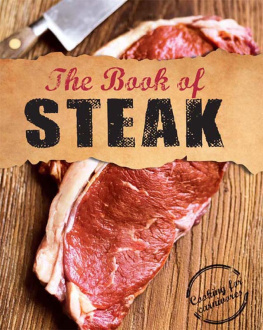STEAK LOVERS COOKBOOK

BY WILLIAM RICE
Illustrations by M. KATHRYN THOMPSON
WORKMAN PUBLISHING NEW YORK
Copyright 1997 by William Rice
Book illustrations copyright 1997 by M. Kathryn Thompson
All rights reserved. No portion of this book may be reproducedmechanically, electronically, or by any other means, including photocopyingwithout written permission of the publisher. Published simultaneously in Canada by Thomas Allen & Son Limited.
Library of Congress Cataloging-in-Publication Data is available
eISBN 9780761178828
Cover and book design by Paul Gamarello
Cover photograph by Louis Wallach
Workman books are available at special discounts when purchased in bulk for premiums and sales promotions as well as for fund-raising or educational use. Special editions or book excerpts can be created to specification. For details, contact the Special Sales Director at the address below.
Workman Publishing Company, Inc.
225 Varick Street
New York, NY 10014-4381
www.workman.com
To my mother, and to Jill, living proof that a marriage can have a better half.

ACKNOWLEDGMENTS
For helping to shape a raw concept into a ready to serve book, Suzanne Rafer, Paul Gamarello, Susan Ramer, Barry Bluestein and Kevin Morrissey, and Susan Derecskey.
For their invaluable contributions in researching steak cookery and steak lore, Diane E. Haglund; Marlys Bielunski, Susan Lamb Parenti, Irene Yeh, Debbie Baughman and B.J. Valenziano of the National Cattlemens Beef Association; Betty Hughes and Carol Moeller of Weber-Stephen; Cate Erickson; Jerry Lekan of Paulina Market, and John Scimca of Johns Finer Foods; Ellard Butch Pfaelzer of the Bruss Company; and Chuck Jolley and Jerry Lyons of Cryovac.
For their passion about steak, their friendship, and for making the steak house all that it can be, Pat Cetta of Sparks Steak House and Bern Laxer of Berns.
For sharing steaks, including some improbable experiments, Pam, Roy, and Irma Van Cleave, Judy and Joe Fell, Debbie and Bob Cummins, Ivan and Janet Kaplan, Jo and Tony Terlato, Vikki and Elliot Brown, Elaine and Mitch Khosrova, Mary and Jim Burns, Betsey and Johnny Apple, Susan and David Brinkley, and from the past, Bobby and Jim.
Finally, thanks to those cooks, professional and amateur, who shared recipes with me, and to my colleagues at the Chicago Tribune for their professionalism and inspiration.
CONTENTS
GREAT STEAK!
Hello. I am here to serve you steak. Not just one steak, but lots of steaks, cooked and presented in lots of different ways.
Im also happy to report these steaks are hot. The 1990s has witnessed the reappreciation of the pleasure of eating a food that everyone can understand and that just tastes good. Once again, the steak dinner is the feast of choice for special occasions and a symbol of American well-being and prosperity. Once again, people speak with real enthusiasm about the excitement of confronting a big, juicy, succulent steak. We say we crave a steak, and we mean it. For me, there is the pleasure and the extra seductive element of pleasure delayed.
Steak, I confess, did not play a large part in my childhood. My mother was a good cook, celebrated within our family for her terrific desserts. But her approach to steak was to buy one that was no more than half an inch thick and cook it until she was sure it was brown all the way through. As a result, steak was not much in demand Chez Rice.
It wasnt until my first year in college that I tasted a steak that was crisp, almost crunchy, on the surface and thick enough to be gloriously pink in the center. And juicy. Ah, how I loved that juice! For that matter, how I loved the outsized, richly dressed salad that came before the steak, the equally outsized baked potato on the plate with the steakindeed the entire experience of dining at a restaurant aptly named The Steak House.

Gifted with an uncommonly good appetite, the thinness of my wallet was the only impediment as I pursued steaks of record sizes over the next few years. I also ate steak raw, marinated, and chicken-fried. Gradually I discovered a wider horizon that included garlic-anointed sirloins swimming in fragrant pizzaiola sauce beside a big portion ot pasta. They ranked right up there with the thin, chewy but incredibly flavorful steak served at second-rank French restaurants. A gob of heavenly butter on top, distributed bits of chopped shallot and parsley over the steak as it melted.
About this time, happily, my chauvinist notion that Americans had the monopoly on preparing great steak was erased. It took only a single visit to the tappen yaki room of a Japanese restaurant. The lightning-fast cutting and cooking on the flattop grill around which we were seated was wonderfully theatrical. The steak was supremely tender. But what impressed me most was the impact of soy sauce and less familiar seasonings on the meat, and the crunch of the barely cooked vegetables served with it.

Eating steaks in restaurants was fun, and, it turned out, a wonderful preparation for what came nextcooking them. As a novice, bachelor cook in the pre-pasta 1960s, when fancy carry-out food came from a deli and was a pastrami sandwich, it was inevitable Id become familiar with steak. There werent many options and it was what everyone wanted to eat.
I progressed from burgers to bavette, the superior version of flank steak sold at Washingtons French Market. A pair of fellow journalists, with whom I shared quarters, were willing collaborators in demolishing my experiments. My Japanese dining experience opened a whole new world, and the delight Ive taken since in using Asian techniques and flavorings to cook steak is reflected in recipes such as Asian Beef Salad with Cucumbers and Thai Red Beef Curry.
As I cooked on, there were opportunities to make side dishes and experiment with sauces. Id doctor a barbecue sauce until it became my own. Copying the French chefs, Id turn a simple pat of butter into a repository for garlic and herbs and more. Making beurre compos, as the French call it, is an invitation to almost limitless innovation.
Composed butters are, I learned eventually, but childs play. With the encouragement of Craig Claiborne, as I neared age thirty, I resigned from the Washington Post, took my meager savings, and enrolled in Pariss famed Le Cordon Bleu.
Talk about the steak-and-potatoes American diet! The French seemed to order steak and potatoes even more often than we did, but they make both in so many different ways that the combination never becomes monotonous. At the school, I learned the difference between filet and entrecte, garnishes for such classics as filet la forestire (with morel mushrooms), entrecte bordelaise (with poached bone marrow), and a remarkable array of sauces. The opportunity to travel led me to Florence, where I devoured the famous T-bone called fiorentina. I found fascinating steak preparations, too, in such disparate environments as Scandinavia and Spain.
Back home and back in journalism, working at the Washington Post, then
Next page















